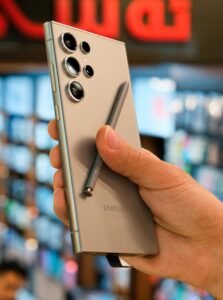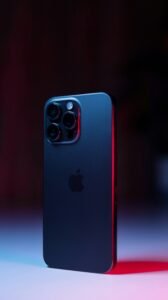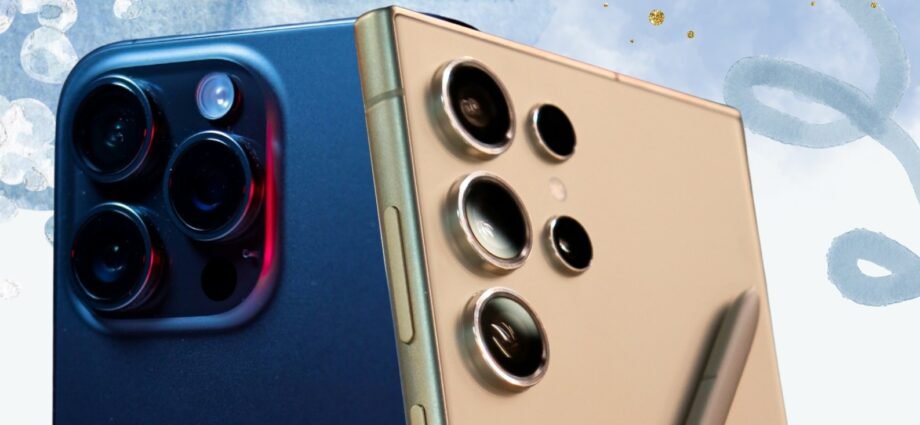Samsung Galaxy S24 Ultra vs iPhone 15: A Technical Showdown
The Samsung Galaxy S24 Ultra (early 2024) and Apple’s iPhone 15 series (late 2023) represent the pinnacle of Android and iOS flagships, respectively. In this deep-dive comparison we’ll break down each device’s design, display, performance, cameras, software features (including AI tools), battery, and build, highlighting strengths and weaknesses of the S24 Ultra against the iPhone 15 (especially the Pro/Pro Max models) with technical detail and citations from expert sources.

Design and Build Quality
- Samsung Galaxy S24 Ultra: Titanium alloy frame, Gorilla Glass Victus 2 front/back, IP68 water/dust resistance. First Ultra model with a flat 6.8-inch display, reducing edge drop risk when using the S Pen. The integrated S Pen slot (stylus latency: ~9 ms) enhances productivity. The phone is large and heavy – about 8.2 oz (232 g) – and as The Verge notes, its sharp flat-to-curved transition corners can feel “uncomfortable” in the hand.

- Apple iPhone 15 (Pro/Pro Max): Pro models use a titanium frame (introduced in 2023) with Ceramic Shield front glass and flat edges, rated IP68. The Pro Max (6.7″) and Pro (6.1″) are significantly lighter: the 6.1″ Pro weighs 187 g (6.60 oz), thanks to titanium’s lower density. All iPhone 15 models now feature USB-C ports. The Pro also adds Apple’s new customizable Action Button (replacing the mute switch). Overall, the iPhone 15 Pro feels more compact and lighter than older stainless-steel models (and lighter than the Samsung), but lacks any stylus support.
Display
- S24 Ultra: 6.8-inch Dynamic AMOLED 2X (Samsung’s branding) with 1440 × 3120 (QHD+) resolution, 120 Hz adaptive refresh, HDR10+ and 0–240 Hz (Samsung scale) refresh. It features a new anti-reflective coating and Gorilla Glass Armor. In testing, the screen can hit a peak brightness of ~2600 nits in sunlight, making it one of the brightest on the market. Samsung’s Always-On Display (AOD) now supports dimmed wallpapers and widgets (inspired by iOS). These enhancements make outdoor visibility excellent, per The Verge.
- iPhone 15 Pro/Pro Max: 6.1″ (Pro) or 6.7″ (Pro Max) Super Retina XDR OLED at 2556×1179 (6.1″) or 2796×1290 (6.7″), 460 ppi (Pro) / 460 ppi (Pro Max). Both feature adaptive 120Hz ProMotion, HDR10/Dolby Vision, and always-on displays. Apple rates them for up to 2000 nits peak brightness in outdoor use (1600 nits HDR). Color and contrast are superb (100% DCI-P3 gamut, 2,000,000:1 contrast). While the S24 Ultra’s peak nit rating is higher, in side-by-side shots, iPhone images often looked more vibrant, suggesting Apple’s color tuning and HDR implementation can make colors “pop” more in bright scenes. In short, both screens are top-tier: Samsung’s has higher raw peak and an anti-glare advantage, while Apple’s has industry-leading color accuracy and HDR processing.
Performance (Chipset, RAM, Benchmarks)
- S24 Ultra: Uses Qualcomm’s Snapdragon 8 Gen 3 (4 nm) globally (no Exynos variants), octa-core (1×3.36 GHz Cortex-X4, 3×3.2 GHz Cortex-A720, 4×2.8 GHz Cortex-A520), Adreno GPU, and typically 12 GB of LPDDR5X RAM (some regions may get 16 GB). In practice, it delivers top-tier Android performance: The Verge notes that it “handled everything I threw at it without a problem” and did not overheat during testing. In Geekbench-style terms, it scores very high (single-core ~2.8K points and multi-core ~9K).
- iPhone 15 Pro/Pro Max: Apple’s A17 Pro (3 nm) SoC with 6-core CPU (2 performance @3.78 GHz + 4 efficiency @2.11 GHz), a new 6-core GPU (with hardware ray tracing), 16-core Neural Engine, and 8 GB RAM. This chip leads all performance charts. Notebookcheck reports that the A17 Pro outperforms its predecessor by ~10–15% in CPU performance and is up to 30% faster than any current Android chip. In real-world terms, the iPhone 15 Pro Max holds a significant edge in raw CPU and GPU benchmarks, as well as gaming performance. Thus, both phones are high-speed, but Apple’s A17 Pro currently edges out the Snapdragon 8 Gen 3 as the fastest smartphone chip. (Samsung’s unit isn’t far behind and will handle gaming and multitasking without hiccups.)
Camera Capabilities
- S24 Ultra: Quad-camera system (leading 200 MP f/1.7, 12 MP ultrawide, 10 MP 3x telephoto, 50 MP 5x telephoto). All support OIS (except UW). The 200 MP main uses pixel binning to achieve a ~12 MP output, delivering extremely detailed daylight shots. Samsung removed the previous 10x lens in favor of a new 5x periscope (50 MP) – trading extreme zoom range for higher telephoto resolution.
- This yields a sharper mid-range zoom, but reduces optical reach (the previous Ultra had a true 10x). The result is excellent image quality with rich detail and good low-light performance (thanks to Night Mode). The Verge praises the camera as “one of the best in the game” with a “fantastic portrait mode”. The S-Pen integration adds fun features, such as Auto Framing and live translation overlay. Samsung’s camera app also exposes extensive Pro controls.
- iPhone 15 Pro/Pro Max: Triple-lens system (all f/1.8–2.8). The Pro Max (for example) has: 48 MP main (24 mm, ƒ/1.78) with second-gen sensor-shift OIS, 12 MP ultrawide (13 mm), and two telephotos: a 12 MP 2x (48 mm) and a 12 MP 5x (120 mm tetraprism, ƒ/2.8). (The standard 15 Pro uses 3x (77 mm) instead of 5x.) Apple’s camera excels in color accuracy and video. Dolby Vision HDR video is supported at up to 4K60 on both the main and ultrawide cameras.
- In practice, reviewers note the iPhone’s images tend to be more “punchy” with higher contrast. In direct tests, Tom’s Guide found that the iPhone 15 Pro Max narrowly outscored the S24 Ultra in a head-to-head photo shootout, citing more vibrant colors and slightly better detail. That said, Samsung’s setup wins at maximum zoom, as it supports up to 100x “Space Zoom” (digital zoom), compared to 15–25x on the iPhone. Overall, both phones take great photos; Samsung offers higher-resolution sensors and a dedicated stylus-assisted UI for snap and draw, while Apple’s computational photography (Smart HDR, Photonic Engine) yields very natural-looking shots and industry-leading video.
Software and AI Features
- Galaxy S24 Ultra (One UI 6.1 on Android 14): Samsung continues its feature-rich One UI shell. It offers extensive customization (themes, always-on widgets, Edge panels, and multi-window multitasking) and long-promised support (a generous 7 years of OS and security updates). The trade-off is significant bloat: pre-installed Samsung apps, carrier apps, and pop-up prompts (Verge notes persistent “check out the S24” push notifications and clickbait in the Weather app). It runs Android 14, featuring enhancements such as Samsung DeX (desktop mode) and Knox security.
Galaxy AI Tools: Samsung has aggressively added on-device AI features branded as “Galaxy AI”. Key tools include Circle to Search (select any text or image area to search it, powered by Google’s generative search) and Live Translate (real-time call or text translation in dozens of languages). It also has chat assistants (smart replies, summarizations, rewriting in messages) and Generative Edit. In the Gallery app, you can remove objects or fill backgrounds using AI (using Google’s models under the hood). The Verge found features like circle-search and call-translation “really handy”, though some generative edits can be hit-or-miss. Overall, Samsung’s AI suite is impressive, but it can feel somewhat scattered.
- iPhone 15 (iOS 17 with “Apple Intelligence”): Apple’s software is leaner and more polished. All iPhones will receive iOS 17, which introduces improvements such as interactive widgets, offline Siri dictation, NameDrop, and enhanced FaceTime. Apple’s new Apple Intelligence (iOS 17/18) features include on-device generative capabilities: innovative text writing tools (summarize or rewrite messages), Image Playground/Wand (generate or tweak images and emojis from prompts), and Siri enhancements (tapping into ChatGPT or providing AI-powered answers).
- For example, you can enable a ChatGPT extension to let Siri craft text from scratch. Apple emphasizes privacy (all AI runs locally and uses on-device context). Unlike Samsung, iOS has minimal bloat and extremely tight integration with Apple’s ecosystem (AirDrop, Continuity, etc.). Apple also pledges many years of iOS updates (typically 6+ years for iPhones). However, Samsung’s 7-year guarantee is now among the longest in the industry. In summary, One UI is more customizable and AI-forward, while iOS is more streamlined and privacy-focused. Android allows more tinkering and features (e.g., DeX, default apps), whereas iOS offers a polished, cohesive experience.
Battery Life and Charging
- S24 Ultra: 5000 mAh battery (actual cell size: ~4855 mAh “rated” by Samsung). In testing, DXOMARK measured ~56 hours of “moderate use” autonomy. The Verge found it “about average” for a modern flagship, getting to bedtime with ~30–50% remaining on most days. Rapid charging is 45 W wired (Samsung’s recommended charger, not included) – approximately 1 hour and 27 minutes to full. Wireless charging is 15 W Qi (no support for the new Qi2 standard). A 5-minute quick charge only adds ~4+ hours of use (weaker than previous models).
- iPhone 15 Pro Max: 4441 mAh battery. Apple claims up to 29 hours of video playback (Pro Max). In practice, the iPhone’s efficiency is excellent: reviewers report that a full day of heavy use is routine. Charging is slower by comparison: the phone supports up to 20–27 W wired (a 20W brick is included for ~50% in 30 minutes), and 15 W MagSafe/Qi2 wireless. (The iPhone also adds Qi2 support, enabling faster next-gen wireless chargers.) Overall, Samsung’s battery capacity and charging rate are higher. However, Apple’s chip and software efficiency give the 15 Pro Max comparable all-day endurance.
- In summary, S24 Ultra has a larger cell and faster wired charging. In contrast, the iPhone charges more slowly. Still, it lasts all day thanks to Apple’s optimized power use (especially in Pro Max form).
Conclusion: Strengths and Weaknesses
- Galaxy S24 Ultra Strengths:
- Spectacular display: Huge 6.8″ QHD+ screen with 2600 nit peak and anti-glare.
- Versatile cameras: 200 MP primary sensor, dual telephoto options (3x and high-res 5x) for great zoom, and S Pen note-taking.
- Performance & RAM: The Snapdragon 8 Gen 3 and 12 GB RAM deliver blazing multitasking power.
- Software updates: Industry-leading 7-year Android support.
- Galaxy AI features: Useful tools (Circle-to-Search, Live Translate, generative photo editing) are built-in.
- Galaxy S24 Ultra Weaknesses:
- Size/weight: Extensive and heavy (~232 g), “unapologetically big”. Corners are sharp to hold comfortably.
- Battery life: Average endurance; wired charging (45 W) is fast but not included, and quick-charge gains are modest.
- Bloatware: One UI has many preloaded apps and pop-ups (though many can be turned off).
- Zoom trade-off: Sacrificing 10x optical tele for 5x improved resolution may disappoint some (further than 5x zoom isn’t as strong as last gen).
- iPhone 15 (Pro/Pro Max) Strengths:
- Build & ergonomics: Premium titanium (on Pro), lighter feel, flat edges, and Apple’s precise assembly. The new Action button adds functionality.
- Display quality: Excellent color accuracy, HDR, 120 Hz ProMotion, and very high brightness (2000 nit). Always-on display on Pro models is polished.
- Performance: The A17 Pro is the fastest mobile SoC (20–30% faster than any other Android SoC), powering a smooth UI and games (with ray tracing support).
- Cameras: Stellar computational photography and video – accurate colors, excellent dynamic range, best-in-class video (Dolby Vision, Cinematic mode). In head-to-head tests, the 15 Pro Max narrowly beat the S24 Ultra in photo quality (punchier colors/detail). The 5x telephoto lens (on Pro Max) provides a 10x optical zoom range.
- Software ecosystem: iOS is highly polished and regularly updated, with new Apple Intelligence features (on-device generative writing, Siri improvements, and ChatGPT integration)—a very long support lifespan.
- iPhone 15 Weaknesses:
- No stylus: Lacks any pencil support or expandable notes features (unlike S24 Ultra’s S Pen).
- Less zoom flexibility: The Pro Max’s 5x telephoto is impressive, but still less optical reach than Samsung’s 100x digital zoom. The base iPhone 15 and 15 Pro only go to 3x.
- Battery/charging: Smaller battery (≈4441 mAh) and slower charging (20W). Though highly optimized, heavy use may require an end-of-day plug.
- Customization: More restricted UI (no DeX, no default app changes, no super widgets), which some power users may find limiting.
Bottom Line: The Galaxy S24 Ultra is a “specs-overkill” powerhouse with a gigantic, ultra-bright screen, top-end cameras and the unique S Pen, but it’s an enormous, feature-packed device that comes at a high cost and average battery life. The iPhone 15 Pro/Pro Max, by contrast, trades off some zoom range and screen size for exceptional build quality, raw processing speed, and finely tuned cameras. Apple’s phone offers a more streamlined, integrated experience (and outstanding video capture). In contrast, Samsung offers more hardware versatility and AI-savvy features. Tech enthusiasts will appreciate both flagships, but the choice comes down to ecosystem preference and whether one values Samsung’s sheer specs (and S Pen) or Apple’s top-tier performance and software polish.
Sources: Technical reviews and official specs from Samsung, Apple, and leading tech outlets.

